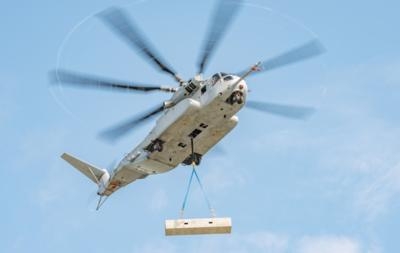Executed An 'Out Of Ground Effect' Test At 100 Feet AGL
The CH-53K King Stallion being developed by Lockheed Martin has successfully completed an external lift of a 27,000 pound payload at Sikorsky's Development Flight Test Center in West Palm Beach, FL.

The aircraft executed an "out of ground effect" (OGE) external load test at 100 feet above the ground while performing hover maneuvers to demonstrate its excellent control authority in this flight regime. An OGE load is the most stressful of lift conditions for a helicopter from a power required standpoint. OGE is defined as an altitude greater than the helicopter's main rotor diameter (79 feet in the King Stallion's case) where power demand greatly increases due to loss of the benefit of ground effect.
"This 27,000 pound external lift is yet another key milestone for the program," said Dr. Michael Torok, Sikorsky Vice President, CH-53K Programs. "The King Stallion achieved this external lift with ease, and we are on track to successfully complete the initial operational assessment this year."
Sikorsky, a Lockheed Martin Company, is developing the CH-53K King Stallion heavy lift helicopter for the U.S. Marine Corps.
The CH-53K has already achieved speeds exceeding 140 knots, and a third CH-53K King Stallion helicopter has joined the flight test program thereby accelerating the pace to full aircraft maturity and production. The first two aircraft have already verified the King Stallion's capabilities well in excess of the predecessor CH-53E. A fourth King Stallion is currently in final preparation for flight status and on track to join the flight test program this summer.
"Lifting 27,000 pounds in OGE conditions is another key milestone for the program, which further confirms our confidence in the design and performance of the aircraft," said Col. Hank Vanderborght, U.S. Marine Corps Program Manager for the Naval Air Systems Command's Heavy Lift Helicopters Program. "This is the most strenuous condition we had to demonstrate from a performance standpoint prior to achieving Milestone 'C' and entering production."
The King Stallion will carry a 27,000 pound external load over 110 nautical miles at 91.5°F at an altitude of 3,000 feet – a Navy operational requirement for "high hot" conditions. The CH-53K helicopter will provide unmatched heavy lift capability with reduced logistics footprint and reduced support costs over its entire life cycle.
CH-53K pilots can execute heavy lift missions more effectively and safely in day/night and all weather with the King Stallion's modern glass cockpit. Fly-by-wire flight controls reduce pilot workload for all heavy lift missions including external loads, maritime operations, and operation in degraded visual environments. With more than triple the payload capability of the predecessor CH-53E, the King Stallion's increased capability can accommodate a range of payloads from an internally loaded High Mobility Multipurpose Wheeled Vehicle (HMMWV) up to three independent external loads at once, providing wide mission flexibility and system efficiency. Additionally, a locking U.S. Air Force pallet compatible cargo rail system reduces both effort and time to load and unload palletized cargo.
The U.S. Department of Defense's Program of Record remains at 200 CH-53K aircraft. The first four of the 200 are scheduled for delivery next year to the USMC. An additional four aircraft are under long lead procurement for parts and materials with delivery scheduled in 2019. USMC initial operating capability is scheduled for 2019. The Marine Corps intends to stand up eight active duty squadrons, one training squadron, and one reserve squadron to support operational requirements.
(Image provided with Lockheed Martin news release)
 ANN's Daily Aero-Term (04.25.24): Airport Rotating Beacon
ANN's Daily Aero-Term (04.25.24): Airport Rotating Beacon ANN's Daily Aero-Linx (04.25.24)
ANN's Daily Aero-Linx (04.25.24) Klyde Morris (04.22.24)
Klyde Morris (04.22.24) Airborne 04.24.24: INTEGRAL E, Elixir USA, M700 RVSM
Airborne 04.24.24: INTEGRAL E, Elixir USA, M700 RVSM Airborne 04.22.24: Rotor X Worsens, Airport Fees 4 FNB?, USMC Drone Pilot
Airborne 04.22.24: Rotor X Worsens, Airport Fees 4 FNB?, USMC Drone Pilot



